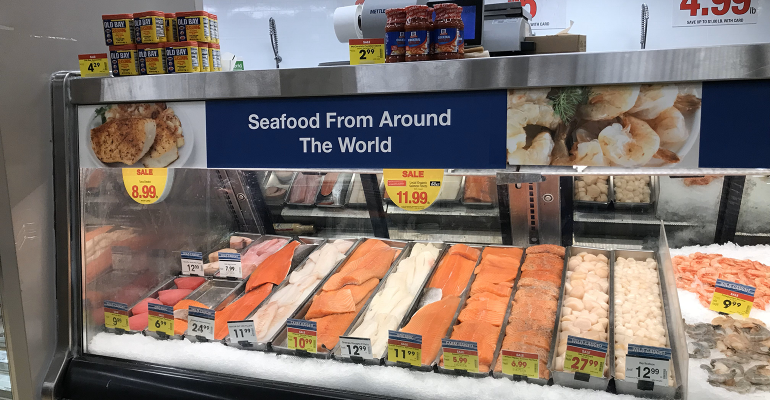Supermarket seafood is not always what it appears to be.
Both flagrant and unintentional misrepresentation of seafood is occurring as products move through the supply chain and onto retail displays. In addition to causing shopper disgruntlement, the incidents can tarnish a retailer’s reputation and impact purchasing activity.
“Seafood managers are highly trusted by consumers,” said Chuck Anderson, vice president and partner with Certified Quality Foods, a Dallas-based analyzer of seafood quality. “That trust must be earned and kept, and ensuring proper labeling is part of that.”
Supply-chain fraud ranges from “simple misunderstandings or lack of information, to blatant deception to increase profits and attempts to launder illegally harvested seafood,” stated NOAA Fisheries, a federal agency responsible for the management, conservation, and protection of living marine resources within about 200 miles of the U.S. coast.
Among such deceptions is substituting a low-valued species for a more expensive one, such as marketing catfish as grouper, as it can be difficult to determine the species of a fish once it has been filleted and skinned, the NOAA noted.
Other measures include short weighting, in which processors misrepresent product weight through such practices as overglazing, soaking, and breading; and mislabeling country of origin to avoid regulations and fees and sneak illegally caught fish into the supply chain, the NOAA stated.
In a supermarket study from late 2017 through 2018 using DNA testing, the New York State Attorney General’s office found that 26.9% of seafood purchases with an identifiable barcode were mislabeled. The seafood was bought at 155 locations that were part of 29 supermarket banners.
About two-thirds of the banners had at least one instance of suspected mislabeling and of the 12 chains with 10 or more samples tested, five had rates of suspected mislabeling that exceeded 50%, the office noted in its “Fishy Business” report.
While there was mislabeling in virtually every tested seafood category, “consumers who buy lemon sole, red snapper, and grouper are more likely to receive an entirely different fish,” the report stated.
“Similarly, consumers who bought what was advertised as ‘wild’ salmon often actually received farm-raised salmon instead. Such consumers had often paid more money — on average 34% more — to avoid farm-raised fish. The substitutes were typically cheaper, less desirable species than the desired species.”
 Data that informs if a product was farm raised or caught in the wild is not always accurate. Photo by Richard Mitchell
Data that informs if a product was farm raised or caught in the wild is not always accurate. Photo by Richard Mitchell
Mislabeling at retail, however, is not necessarily intentional. The report stated, for instance, that wholesale or retail sellers may lack effective protocols for identifying the fish they are selling or differentiating between distinct species within a single broader category.
“For both the consumer and retailer, distinguishing between similar-appearing species accurately can be especially challenging if the seafood is sold in parts (e.g., fillets), rather than as whole fish,” the report noted. “Intentional fraud, negligence, or errors earlier in the supply chain — at the dock or by a distributor — can result in mislabeling at the point of sale to the ultimate consumer.”
The wide variety of selections and complex, seasonally dynamic supply chains can result in mislabeling as well, Anderson said.
“A large full-service seafood department will handle hundreds of different species, resulting in thousands of possible product combinations,” he said, noting for instance, that there are dozens of species of snapper alone.
“These snappers are sourced from many countries, including the United States, Mexico, Costa Rica, Panama, Ecuador, Peru, Colombia, the Philippines, and Indonesia,” Anderson said. “The fish can be fresh or thawed, and while most are wild, many are farm-raised as well. What could go wrong?”
He estimated that mislabeling that occurs at retail outlets is below 5% and is typically an unintentional error by lightly trained frontline workers trying to execute complicated labeling requirements for products with potentially complicated supply chains.
Such elements as country of origin, fresh or thawed, and wild or farmed are far more likely to be mislabeled at retail than species, Anderson said, adding that mistakes are more likely to occur in high-volume seafood departments.
Mislabeling in supermarkets, however, may increase as operators offer additional value-added offerings, he said, with the inaccurate pinpointing of allergens in ready-to-cook seafood a possible risk. “Proper allergen labeling should always be a top priority for retailers and included in internal seafood audits,” he said.
Country of origin, meanwhile, is perhaps the most challenging to identify and fix in retail outlets as it relies on keeping track of paperwork, labels, and signage, Anderson said.
To help reduce species mislabeling, retail buyers and merchandisers should reference the U.S. Food and Drug Administration’s seafood list, which details the acceptable market name for each fish species, Anderson said.
In addition, employee training should cover species identification for common products and stress the importance of properly labeling country of origin, method of production, allergens, and if the product is fresh or frozen, he said.





